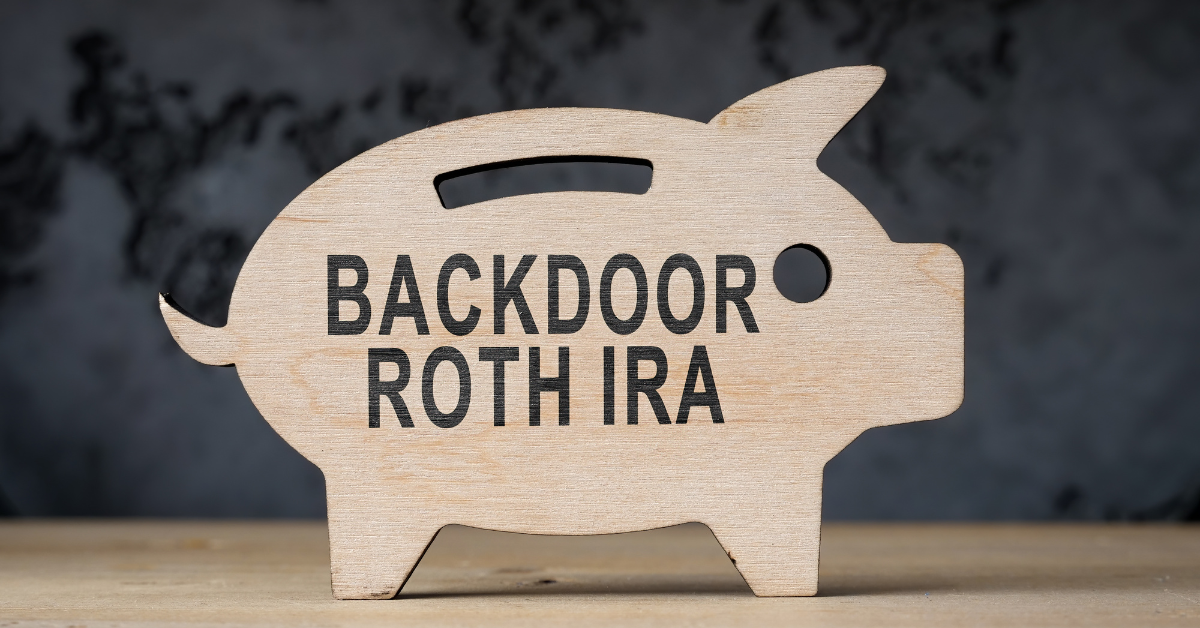How a Mega Backdoor Roth Conversion Works
June 10, 2022
How a Mega Backdoor Roth Conversion Works
June 10, 2022
Share this post:
Last Updated: March 13, 2024

It’s no secret that Roth individual retirement accounts (IRAs) have several major benefits—after-tax contributions to your IRA account offer tax-free growth and distributions later in life, and there are no required minimum distributions at any age. Plus, you can withdrawals amounts equivalent to your Roth contributions penalty- and tax-free for any reason before age 59½, the usual age for taking penalty-free distributions on your retirement accounts (though, we advise you tread carefully on taking distributions out of any retirement account, as this can set you back, sometimes significantly, in your retirement savings journey).
However, they do come with several major limitations: namely, income and contribution limits. In 2024, you can contribute up to $7,000 to a Roth IRA and $8,000 if you’re over 50. Additionally, if you’re a single filer and earn a modified adjusted gross income (MAGI) of $129,000+ annually, the amount you can contribute to your Roth IRA reduces until phasing out completely at $144,000. For married couples filing jointly, contribution amounts reduce beginning at a MAGI of $204,000 and phase out completely at $214,000. So, if you’re a high earner, Roth IRAs may not be available to you at all as a retirement savings option.
But here’s where a backdoor Roth conversion may come in. There are two types of these conversions: the standard backdoor Roth conversion and the mega backdoor Roth conversion.
What is a Backdoor Roth Conversion?
A backdoor Roth conversion is available to anyone who contributes to a traditional IRA (or is rolling a 401(k) into a traditional IRA); they can convert their traditional IRA to a Roth, even if they make more than the Roth IRA income limits. They must pay the taxes upfront on the amount converted if using an account funded with pre-tax dollars, as Roth accounts are funded using after-tax dollars and distributions are tax-free. They have to pay taxes on the growth/earnings if they are using a non-deductible traditional IRA funded with after-tax dollars.
Because specific tax rules exist, it’s advisable to consult with a tax professional before converting or taking withdrawals from any retirement accounts to avoid unnecessary penalties and taxes, if possible.

How a Mega Backdoor Roth Conversion Works
Now, let’s get to what we’re really here to talk about: the mega backdoor Roth conversion, a special 401(k) rollover strategy that can help those with high incomes transfer funds into a Roth IRA. A mega backdoor Roth IRA conversion is a tax-benefitted strategy those with high salaries might be able to use to amplify their retirement savings and provide tax shelter to investment growth in retirement. When specific requirements are met, this strategy can help you tuck away extra money for your retirement. The main difference between a mega backdoor Roth and the standard backdoor Roth discussed above is that the mega backdoor Roth is funded using 401(k) assets.
Contribution limits to 401(k)s are significantly higher than IRAs—in 2024, individuals can contribute up to $23,000 to a traditional 401(k), with catch-up contributions totaling an additional $7,500 for those 50 and older. This means that if you’re 50+, you can contribute up to $30,500 annually to your 401(k). But this isn’t the true limit for 401(k) contributions—this is simply the elective employee deferral amount that we most often hear about. The limit for total combined contributions to your 401(k), including your, your employer matching, profit sharing, and after-tax contributions (if available) is $69,000 for 2024 ($76,500 for those 50+). Compare this to the $7,000–8,000 limit on IRAs, depending on your age, and you might see why this strategy can be so beneficial to your retirement savings. So, the mega backdoor Roth allows for additional contributions beyond your elective deferral amount up to $46,000 in 2024.
For both types of conversions, you can roll any amount of money in existing traditional IRAs or 401(k)s into your backdoor Roth conversion. But keep in mind that you may be facing a hefty tax bill on the rollover amount if pre-tax money, either from your contributions or investment earnings, are in that account. It’s absolutely worth consulting your financial and tax professional to discuss doing this before taking any action.
It’s also important to act quickly to convert your after-tax contributions by in-service withdrawal, as you don’t want to leave the funds in long enough to accumulate investment earnings, as gains are taxed in the conversion. Check with your plan provider to determine if they allow automated in-plan conversions; if not, a financial planner or other financial or tax professional may be able to help you with this process. If you don’t manage a timely in-service withdrawal or in-plan conversion and you accumulate gains, don’t worry too much: The IRS allows you to move your after-tax contribution into a Roth and your gains into a traditional IRA.
Is a Mega Backdoor Roth Conversion Possible for You?
Two requirements must be met to do a mega backdoor Roth conversion:
- Your 401(k) plan must allow for after-tax contributions.
- Your 401(k) plan must allow for in-service withdrawals or in-plan Roth conversions, which mean you can move the money out of your 401(k) while still employed at the company sponsoring your 401(k), perhaps to roll it into another retirement account. In-plan Roth conversions allow you to convert your after-tax 401(k) contribution to Roth dollars within your 401(k)—this is a bit rarer than plans that allow in-service distributions.
Your HR department or plan administration can help you determine if your plan allows for this. Also, some plans do cap the amount you can contribute after-tax, so this is another question to follow up on. If your plan doesn’t allow for the mega backdoor Roth, you might still be able to do the standard backdoor Roth conversion. You can also check with your employer to see if they offer a Roth 401(k) plan—another retirement account that offers tax-free growth and distributions in retirement.

When a Mega Backdoor Roth Might Be Right for You
A mega backdoor Roth conversion can be a very effective way to save even more for retirement if the following are met:
- You earn more than the Roth IRA income limits, making you ineligible to open or contribute to a Roth otherwise.
- You’re looking for a way to add more to your retirement savings.
- You’ve maxed out your individual 401(k) contributions.
- You have the funds to make additional after-tax contributions after taking care of other important financial goals.
- Your 401(k) plan accommodates the prerequisites above to complete a mega backdoor Roth conversion.
As this is a more complicated retirement strategy with many requirements, tax implications, and other moving parts, it’s best to consult with a financial and tax professional before considering a mega backdoor Roth conversion or taking any action to do one.
If you want to learn about more personalized and advanced strategies, schedule a 15-minute call with our team.
Schedule Your Complimentary 15-Minute Call
Want expert retirement and investing advice? Subscribe to our YouTube channel and check out our weekly podcast with The Sandman!
Listen to Protect Your Assets anywhere you get your podcasts:
Standard Disclosure
This blog expresses the author’s views as of the date indicated, are subject to change without notice, and may not be updated. The information contained within is believed to be from reliable sources. However, its accurateness, completeness, and the opinions based thereon by the author are not guaranteed – no responsibility is assumed for omissions or errors. This blog aims to expose you to ideas and financial vehicles that may help you work towards your financial goals. No promises or guarantees are made that you will accomplish such goals. Past performance is no guarantee of future results, and any expected returns or hypothetical projections may not reflect actual future performance or outcomes. All investments involve risk and may lose money. Nothing in this document should be construed as investment, tax, financial, accounting, or legal advice. Each prospective investor must evaluate and investigate any investments considered or any investment strategies or recommendations described herein (including the risks and merits thereof), seek professional advice for their particular circumstances, and inform themselves about the tax or other consequences of any investments or services considered. Investment advisory services are offered through Liberty Wealth Management, LLC (“LWM”), DBA Liberty Group, an SEC-registered investment adviser. For additional information on LWM or its investment professionals, please visit www.adviserinfo.sec.gov or contact us directly at 411 30th Street, 2nd Floor, Oakland, CA 94609, T: 510-658-1880, F: 510-658-1886, www.libertygroupllc.com. Registration with the U.S. Securities and Exchange Commission or any state securities authority does not imply a certain level of skill or training.
References
Boone, Clayton, & Mormino, Matt. (March 1, 2022). Mega Backdoor to Boost Your Roth Retirement Savings. Brighton Jones. https://www.brightonjones.com/blog/mega-backdoor-roth-retirement-savings/
Coombes, Andrea. (March 2, 2022). Mega Backdoor Roths: How They Work in 2021. Nerdwallet. https://www.nerdwallet.com/article/investing/mega-backdoor-roths-work#:~:text=The%20mega%20backdoor%20Roth%20allows,2021%2C%20and%20%2440%2C500%20in%202022
Napoletano, E., & Curry, Benjamin. (December 22, 2021). Is the Mega Backdoor Roth Too Good to Be True? https://www.forbes.com/advisor/retirement/mega-backdoor-roth/
Scott, Michelle. (April 3, 2022). Mega Backdoor Roth 401(k) Conversion. Investopedia
